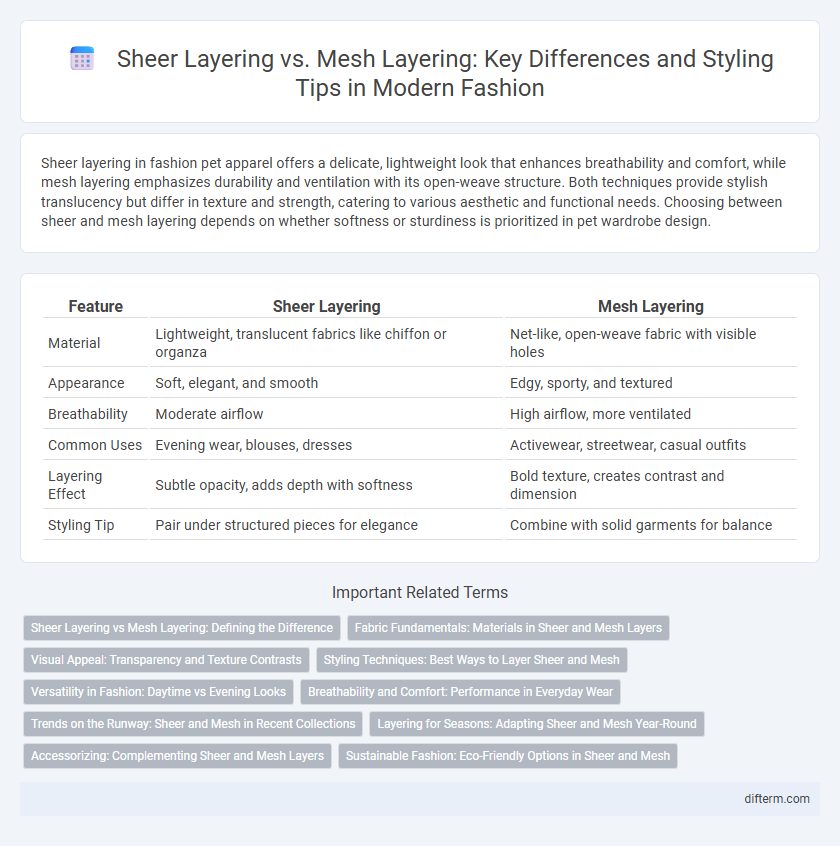Sheer layering in fashion pet apparel offers a delicate, lightweight look that enhances breathability and comfort, while mesh layering emphasizes durability and ventilation with its open-weave structure. Both techniques provide stylish translucency but differ in texture and strength, catering to various aesthetic and functional needs. Choosing between sheer and mesh layering depends on whether softness or sturdiness is prioritized in pet wardrobe design.
Table of Comparison
| Feature | Sheer Layering | Mesh Layering |
|---|---|---|
| Material | Lightweight, translucent fabrics like chiffon or organza | Net-like, open-weave fabric with visible holes |
| Appearance | Soft, elegant, and smooth | Edgy, sporty, and textured |
| Breathability | Moderate airflow | High airflow, more ventilated |
| Common Uses | Evening wear, blouses, dresses | Activewear, streetwear, casual outfits |
| Layering Effect | Subtle opacity, adds depth with softness | Bold texture, creates contrast and dimension |
| Styling Tip | Pair under structured pieces for elegance | Combine with solid garments for balance |
Sheer Layering vs Mesh Layering: Defining the Difference
Sheer layering uses lightweight, translucent fabrics like chiffon or organza to create soft, flowing silhouettes with a delicate, ethereal effect. Mesh layering features open-weave materials such as tulle or netting, offering a more textured, edgy look with visible patterns and enhanced breathability. Understanding the contrast between sheer's smooth transparency and mesh's structured openness is essential for mastering layered fashion styling.
Fabric Fundamentals: Materials in Sheer and Mesh Layers
Sheer layering relies on lightweight, translucent fabrics like chiffon, organza, and voile that offer delicate breathability and soft drape, enhancing elegance and subtle exposure of underlying textures. Mesh layering utilizes more structured, open-weave textiles such as tulle, netting, and synthetic meshes, providing durability and a sportier aesthetic with varied transparency levels. Both fabric types emphasize breathability and visual interest but differ in texture, opacity, and structural integrity crucial for fashion layering designs.
Visual Appeal: Transparency and Texture Contrasts
Sheer layering offers a delicate transparency that creates a soft, ethereal visual appeal, showcasing subtle skin tones beneath lightweight fabrics like chiffon or organza. Mesh layering introduces a pronounced texture contrast with its open-weave structure, adding edginess and dimension through varied patterns of transparency and opacity. Combining these techniques emphasizes dynamic interplay between smooth sheerness and tactile mesh surfaces, enhancing depth and complexity in modern fashion ensembles.
Styling Techniques: Best Ways to Layer Sheer and Mesh
Sheer layering involves combining lightweight, translucent fabrics such as chiffon or organza to create depth and softness, often pairing with solid basics for balanced contrast. Mesh layering emphasizes texture through open-weave patterns, best styled by integrating structured pieces underneath to highlight the fabric's geometric design. Mixing sheer and mesh requires attention to proportions and color coordination, ensuring a harmonious blend that enhances the garment's visual interest and maintains comfort.
Versatility in Fashion: Daytime vs Evening Looks
Sheer layering offers a delicate, translucent effect ideal for both casual daytime outfits and elegant evening ensembles, allowing seamless transition between settings. Mesh layering provides a bolder texture, enhancing sporty or edgy daytime looks while adding depth and intrigue to nighttime fashion. Both techniques elevate versatility by enabling creative blending of fabric transparency and style for diverse occasions.
Breathability and Comfort: Performance in Everyday Wear
Sheer layering offers lightweight breathability with its fine, translucent fabrics that allow air to flow freely, enhancing comfort during everyday wear. Mesh layering excels in ventilation through its open-knit structure, providing superior airflow and moisture-wicking properties ideal for active or warm conditions. Both techniques balance style and functionality, but mesh generally outperforms sheer in maximizing breathability and sustained comfort during prolonged use.
Trends on the Runway: Sheer and Mesh in Recent Collections
Sheer layering and mesh layering have dominated recent runway collections, showcasing designers' innovative use of transparency to create depth and texture. Fashion houses like Dior and Balmain emphasize sheer fabrics for elegance and fluidity, while brands such as Alexander Wang employ mesh materials to add an edgy, sporty vibe. These trends highlight a growing preference for lightweight, breathable textiles that combine sensuality with modernity in contemporary fashion.
Layering for Seasons: Adapting Sheer and Mesh Year-Round
Sheer layering offers a lightweight, breathable option ideal for spring and summer, enhancing outfits with translucent textures that add depth without overheating. Mesh layering provides durability and ventilation, making it suitable for transitional months and cooler seasons by allowing warmth to escape while maintaining style. Both techniques adapt seamlessly year-round, enabling versatile, temperature-conscious ensembles that balance comfort and fashion.
Accessorizing: Complementing Sheer and Mesh Layers
Accessorizing sheer layering involves opting for delicate, minimalist jewelry to maintain the ethereal quality of the fabric, such as thin gold chains and subtle stud earrings that enhance without overpowering. Mesh layering calls for bolder accents like chunky bracelets or statement belts, which add texture and contrast to the edgy, breathable material. Both styles benefit from carefully chosen bags and shoes; transparent clutch bags pair well with sheer layers, while rugged boots or sneakers complement mesh ensembles for a balanced, fashion-forward look.
Sustainable Fashion: Eco-Friendly Options in Sheer and Mesh
Sheer layering and mesh layering offer eco-friendly options in sustainable fashion by utilizing recycled fibers and biodegradable fabrics to reduce environmental impact. Brands increasingly incorporate organic cotton mesh and plant-based sheer materials that ensure breathability while minimizing waste. These innovations promote longevity and recyclability, aligning fashion trends with green practices.
Sheer Layering vs Mesh Layering Infographic

 difterm.com
difterm.com